One of the ways to establish heating in residential or non-residential premises is to install equipment not in a boiler room or inside a building, but on the street. Outdoor gas boilers can be responsible for heating the house. These are standard units in a heat-insulated casing with a chimney and a pipeline connecting them to the heated rooms.
The complexity of the installation of the PRC lies in the requirements imposed by the supervisory authorities, as well as in the conditions for their location. Consider the design and installation features of outdoor equipment, despite the fact that there is no separate legislative framework for this type of heating equipment.
The content of the article:
-
Outdoor gas boilers
- Purpose and main functions
- Types and design features
-
The nuances of the installation of the PRC
- Installation conditions for gas structures
- Chimney requirements
- Installation and connection rules
- Start-up and operating requirements
- Conclusions and useful video on the topic
Outdoor gas boilers
Many Russian and foreign enterprises are engaged in the production of outdoor installations. The main advantage is that powerful units do not require the construction of a separate boiler room, but are fully protected from mechanical damage, cold and rain.
Various models of outdoor gas boilers are designed to operate on natural gas, liquefied gas and biogas, have an efficiency of 85-95%. The pressure in the system and the outlet water temperature differ, but for some units, they are regulated using automation.
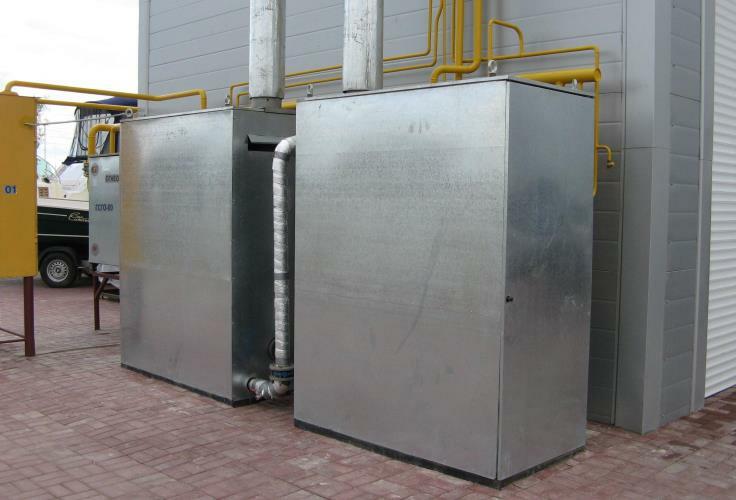
Outdoor gas equipment is an innovative analogue of a modular boiler house, which is distinguished by energy saving and allows you to save on the arrangement of the heating unit
Gas requirements documentation:
- Biogas - GOST 27577-2000;
- Natural - GOST 5542-2014;
- Liquefied - GOST 20448-90.
Installation, commissioning and maintenance are usually carried out by the manufacturer's employees. The constant presence of service personnel is not required.
Purpose and main functions
It is necessary to distinguish the PRC from boiler houses, since according to all documents and legislative acts, they represent a separate group of heating equipment. And although they are often called mini-boiler rooms, the installation is carried out according to completely different rules.
Street boilers are used to heat both residential and industrial facilities. They are installed to serve kindergartens, schools, hospitals, entertainment, shopping and sports centers. Sometimes they act as a backup source, especially where a continuous supply of heat is required.

For small buildings, single boilers of low power are used - 40-100 kW. Typically, such equipment is designed for heating an area of up to 1000 m³
If you need to heat a country house, then low-power equipment is quite suitable for this. Large buildings and industrial enterprises require more powerful equipment; complexes of 2 or more boilers are installed for them.
Outdoor units are increasingly used due to the following features:
Image gallery
Photo from
Installation of boilers does not require the construction of a boiler house, therefore, for consumers it is possible to set more sparing prices for hot water and heat
Modern models are equipped with burners of reduced size, therefore they work almost silently and are mounted next to houses
Automatic equipment monitors the pressure and temperature of the coolant, and a special system monitors the level of concentration of harmful gases and stops the gas supply in the event of a leak
The boiler casing is a metal casing made of high-strength steel, pipes are produced using a seamless method. Boiler manufacturers give a guarantee of 1-2 years, the equipment is designed for operation from 10 to 15 years
Saving money for installation and operation
Low noise level
Safety for residents or staff
High quality workmanship and durability
It is also convenient for use that the units are compact in size, while possessing high power. They do not require constant attention; for maintenance, it is enough to remotely monitor the operation of the boilers in normal mode.
Types and design features
Models of domestic and industrial gas boilers for outdoor installation - prefabricated water-tube structures for heating water. To protect against external aggressive factors, they are enclosed in metal boxes insulated on all sides with mineral wool or other heat-insulating material.
The models differ in design, but most often the principle of their operation is to use a gas burner. After mixing with air, the fuel goes to the multi-flame burner. The fine-perforated gas burner breaks the jet of fuel into parts, resulting in complete combustion. The holes located in the upper part are responsible for traction and air supply.
Pipelines and electrical cables connect the building and the boilers, therefore they are brought into the building, where the remote control is also installed. The boiler can be controlled directly from the office located inside the building.
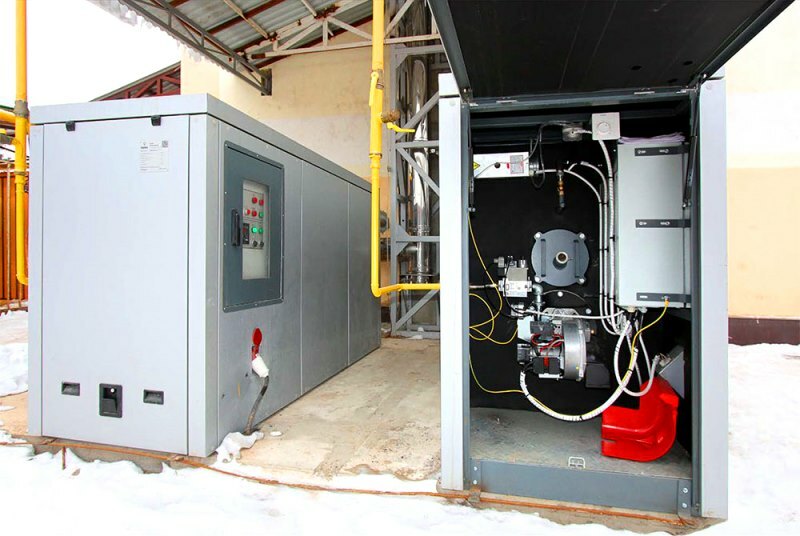
Additionally, outdoor gas boilers are equipped with a chimney, fire alarm and automatic equipment for immediate signal transmission in the event of an emergency.
Heating equipment automatic devices able:
- ignite the burner;
- control the operation of light and sound alarms;
- turn off the burner if the fuel indicators deviate from the established ones;
- shutdown the system if a leak occurs;
- maintain the volume and temperature of the coolant, etc.
Most of the units, especially low-power representatives, do not require foundation preparation - strengthening the foundation. The finished equipment is simply brought to the chosen place and set according to the level.
For access to the burner and technical units located inside the metal box, one or two walls open.
There are two types of boilers: single and double. Now there are built-in ones, but the initial models are more popular - if increased power is required, they simply install several boilers.
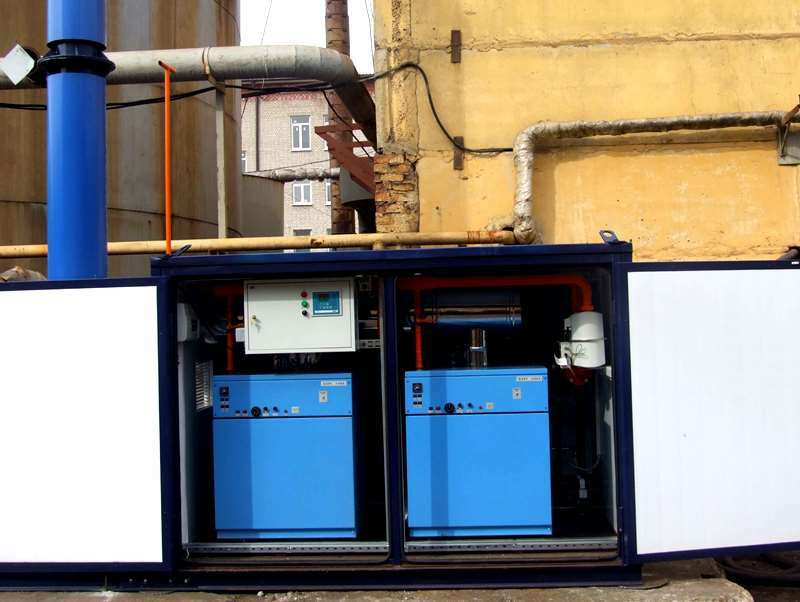
Twin models differ in that they are equipped with 2 fireboxes, 2 heat exchangers and 2 burners. If single ones have power indicators of 40-500 kW, then double ones most often - 80-800 kW
The basic model is completed with:
- instrumentation;
- a system of mesh filters;
- pipelines;
- sensors;
- fittings;
- safety valve.
To increase the efficiency of work, external boilers are equipped with circular pump. For models operating on medium / high pressure gas, installation of gas control units is provided.
Chimneys have different designs, but sandwich chimneys insulated with basalt wool are recognized as effective. They heat up quickly, which minimizes the formation of condensation, and in the cold season - ice on the walls.
The nuances of the installation of the PRC
Installation of outdoor gas boilers is carried out in accordance with the existing regulatory documentation. But it says either about boilers for internal use, or about boiler rooms located in separate rooms, therefore, controversial issues may arise that are resolved by both gas services and service companies, and Rostekhnadzor.
The main thing is to be able to negotiate with representatives of all instances and skillfully operate with the provisions of SNiP and GOST.
For those who want to study the regulatory framework, we suggest studying the following documents:
- SP 41-104-2000;
- SNiP 42-01-2002;
- SP 42-101-2003.
But the main document for the installation and operation of equipment is manufacturer's technical manual.
Installation conditions for gas structures
The PRC is a completely ready-to-use structure that requires connection and commissioning, therefore, for their installation, only a flat base and permission for installation work are required.
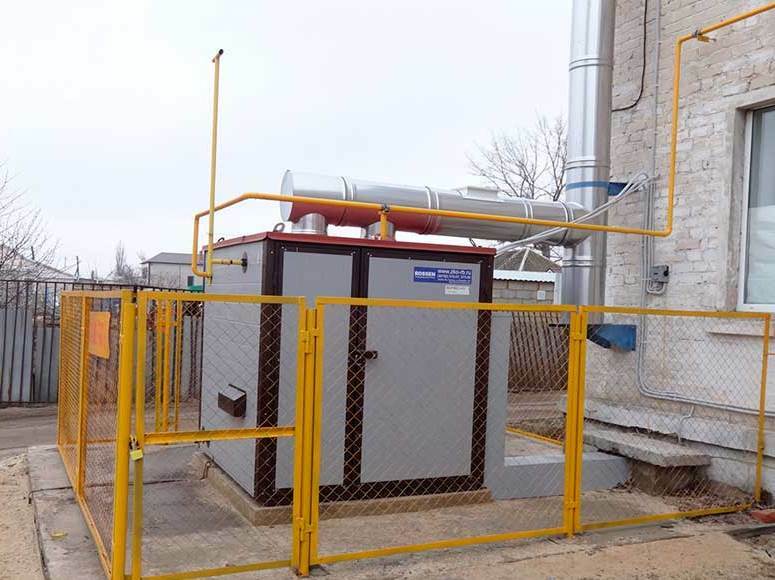
For the most powerful boilers, a foundation is also needed - this is prescribed in the unit's data sheet. Concrete slabs or pouring are used as a foundation.
Before installation, it is necessary to obtain technical specifications from the gas service, which, in turn, is guided by the requirements of the Technical Regulations. The rules for issuing special technical conditions are set out in Ordinance 1314 (2013), where it is said that the reason for the failure of the installation may be solely the lack of technical ability to connect the boiler to the facility.
V GOST R 54961-2012 it is indicated that the specification is agreed upon after checking the compliance of the equipment power, as well as the connection point.
Chimney requirements
Street structures, in the same way as conventional gas boilers, are equipped with chimneys, which are subject to the following requirements:
- the pipe diameter must be equal to or greater than the boiler branch pipe;
- production material - gas-tight;
- installation of a condensate trap is required;
- the direction of the structure is strictly vertical, in special cases - the angle of inclination is up to 30 °;
- joints must be sealed;
- the height of the chimney eliminates smoke in the living area and provides good draft - from 5 m or more.
The upper part of the chimney of outdoor gas boilers is closed in the same way as in conventional boilers. deflector - a hood from debris, dirt and street dust.

Manufacturers recommend choosing straight pipes that have no more than 3 turns with a radius of curvature equal to or greater than the pipe diameter
The installation of factory-made pipes moves from the bottom up, starting from the boiler. The joints of tees, bends, corner elements are additionally fastened with clamps. If the pipe is attached to the wall, then brackets are installed at intervals of 2 m.
Detailed requirements for the selection and installation of PRC chimneys are set out in DBN V.2.5-20-2001 and SNiP 2.04.05-91.
Installation and connection rules
The placement and connection of equipment to the central gas supply system is carried out in accordance with the drawn up and agreed project. Small in weight and volume, boilers do not require the construction of a foundation.
They are installed on a flat area of ground so that the load is distributed evenly over the entire site. For dimensional devices, the foundation construction plan is also included in the general project.
Depending on the manufacturer's recommendations, the unit is placed next to the wall of the heated object, at a distance of up to 50 m or on the roof.
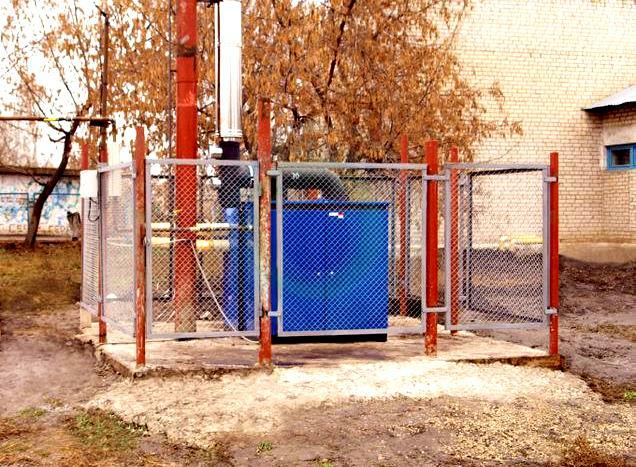
If the gas boiler is located in an area open to unauthorized persons, it must be surrounded by a fence that prevents entry
According to the rules, it is necessary to ground the structure, since the boiler is connected to the power supply system. She is responsible for the operation of burglar alarms, pumps and other automatic equipment.
The unit is connected to the internal heating system with pipes for supplying a coolant with a diameter of 50 mm. The pipeline passes through the wall in a sleeve that protects it. Entry structures inside the building are equipped with shut-off valves.
First, the internal system is cleaned and pressurized, and based on the results - if there is no leakage, rupture, pressure drop in the network - they are connected to the boiler. In the process of pressing, the shut-off valves are closed. The heating system must be equipped with air vents at the top points and a drain valve at the bottom.
Inside the building they install expansion tank, selected taking into account the volume and coefficient of expansion of the liquid, pressure and other important parameters.
Start-up and operating requirements
Before putting the boiler into operation, first prepare the heating system: set the recommended pressure, open shut-off valves on pipes and in the thermal-mechanical compartment of the unit, fill the heating network with water, eliminate errors, drain air.
Then voltage is applied to the boiler and the correctness of the phase connection is checked according to the diagram. At the same stage, the operation of automatic equipment is diagnosed - a control and alarm panel. Last of all, the pump is started and its operation is checked.

The operation of the boiler must be monitored by the owner of the gas equipment. Inspections, adjustments, preventive measures, repairs are carried out by the service organization
The cleanliness of the filters needs to be checked regularly. In case of contamination, the taps are closed, the water is drained, the filters are removed and the mesh is washed.
If the boiler is turned off for the winter period, the heating system and the unit itself are completely freed from water so that the coolant does not freeze in the pipes and break them.
Conclusions and useful video on the topic
PRC maintenance:
Overview of the standard model from the manufacturer:
It will not work independently and at random to purchase a gas outdoor boiler for heating a private house. It must be declared in the gasification project of the house, and all work must be carried out by the hands of specialists or under their supervision.
Unauthorized connection of gas equipment of any type to the house threatens the safety of residents, and is punishable by fines from the controlling organizations.
Do you want to talk about how you installed a gas boiler during the arrangement of your country house? Do you have any useful information on the topic of the article that is worth sharing with your site visitors? Please write your comments in the block form below, ask questions, post photos.


